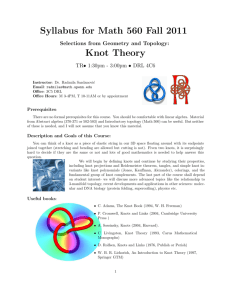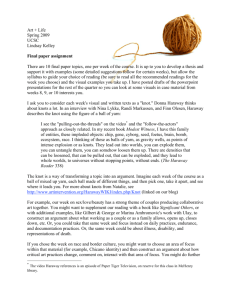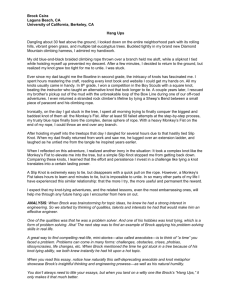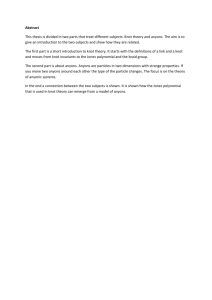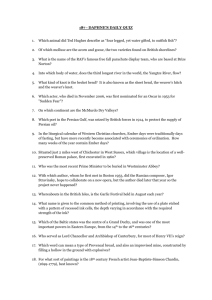CROSSCAPS AND KNOTS BRADD EVANS CLARK
advertisement
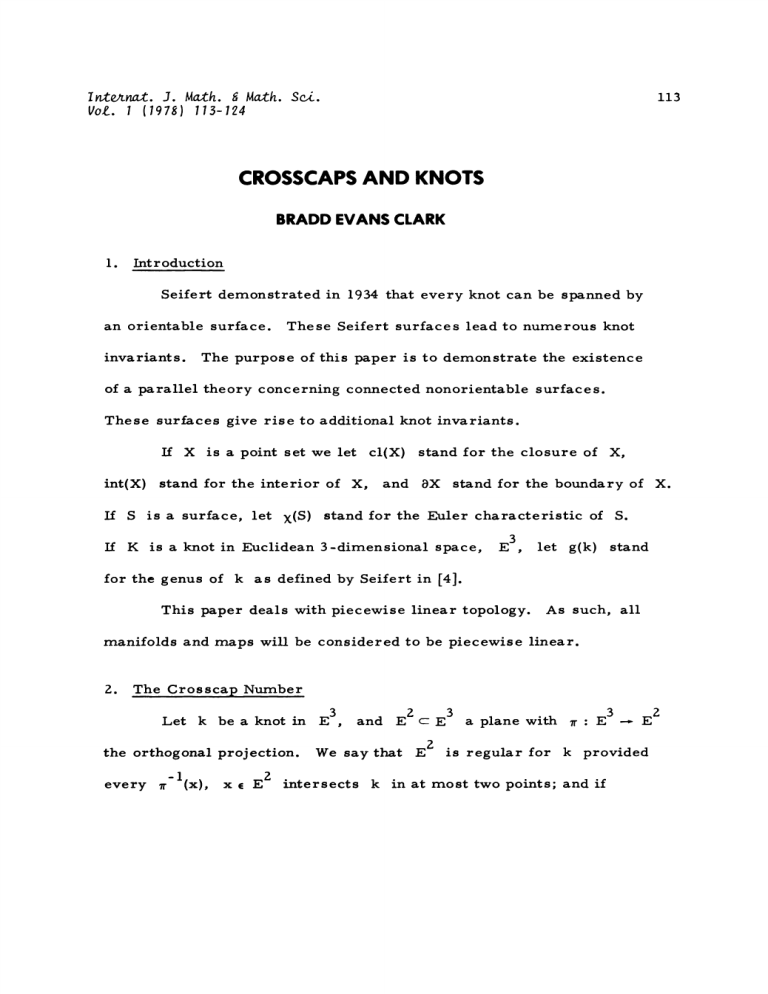
I nternat. J. Math. Math. Sci.
(1978)113-124
Vol.
113
CROSSCAPS AND KNOTS
BRADD EVANS CLARK
I. Introduction
Seifert demonstrated in 1934 that every knot can be spanned by
an orientable surface.
invariants.
These Seifert surfaces lead to numerous knot
The purpose of this paper is to demonstrate the existence
of a parallel theory concerning connected nonorientable surfaces.
These surfaces give rise to additional knot invariants.
If X is a point set we let cl(X) stand for the closure of X,
int(X) stand for the interior of X, and 8X stand for the boundary of X.
If S is a surface, let
x(S)
stand for the Euler characteristic of S.
If K is a knot in Euclidean 3-dimensional space,
for the genus of k as defined by Seifert in
E
3,
let g(k) stand
[4].
This paper deals with piecewise linear topology.
As such, all
manifolds and maps will be considered to be piecewise linear.
Z. The Crosscap Number
Let k be a knot in E
the orthogonal projection.
every
-I
7r
(x), x
,
E
z
3
3
2
and E cE a plane with
We say that E
z
E
3
E
is regular for k provided
intersects k in at most two points; and if
2
114
r
-1
in
B.E. CLARK
(x) 0 k contains two points, neither
[3]
is a vertex of k.
Reidemeister
described the fcheckerboard surfaces f associated with a regular
projection of k.
Theorem 2. I.
If k is a nontrivial knot and E
which is regular for k,
Z
is any plane
then at least one of the associated checkerboard
surfaces is nonorientable.
Proof: Let us call the checkerboard surfaces associated with
k and the orthogonal projection
crossing of k,
respect to r.
both S
1
and S
E
2
3
E
Z
S1
and
$2.
At each
contain a disk which is twisted with
We place an orientation on k.
Then one of the twisted
disks must disagree with the orientation given k.
Suppose that
S1
is
the surface which contains that twisted disk
Figure 1
If S
1
is orientable, then we can use the orientation of the
surface to reorient the knot.
At the crossing under consideration, we
115
CROSSCAPS AND KNOTS
would have to leave one arc of k with the same orientation and another
arc of k would have to change its orientation.
Since k is a simple
Therefore S 1 is nonorientable.
closed curve, this is a contradiction.
Consider a nonorientable surface S which spans a knot k.
we were to sew a disk to
?--manifold.
If
S, we would obtain a nonorientable closed
This manifold could be considered as the connected sum
of n projective planes.
Let C(S)
1
(S)
n.
Definition: The crosscap number of a knot k,
C(k), is the
minimum value for C(S) where S stands for any nonorientable surface
spanning k in E
3.
For completeness we shall define C(k)
0 if
and only if k is the unknot.
1 if and only if k is a (2, n) cable
Proposition Z.Z.
C(k)
Proof: If C(k)
I, then there is a MObius band B which
knot.
spans k. The centerline of B is a knot, which makes k a (2, n)
cable about that knot.
If k is a (g,n) cable about a knot, the construc-
tion of a spanning Mbius band is clear.
A study of embeddings of MJbius bands in S
Kyle in
3
was made by
[Z].
Corollary g. 3.
with C(k)= I.
There exist knots of arbitrarily large genus
B.E. CLARK
116
If S is a nonorientable surface spanning a knot k, we can
think of S as a disk D and a collection of handles
will consist of two arcs,
of D X I into S
3
and
ai2.
such that f(D X
{1/2})
ail
{hi}.
Aso,
D
We can find an embedding f
D and f(DX I)
h
ail U aiz
i
We can also find a collectinn of embeddings f. of h.
1
for all i.
1
such that
f(D X I) fl
fi(hi X
fi(hi
{zl--})
I)
hi, fi(hi X I) ] fj(hj I)
f((ail U ai2 x I) fi((ail U ai2
Definition: We define D(S),
h.1
the double of S,
I
# j, and
if i
X I).
to be
n
fi(hi x {0, I}) U
f(D x
Theorem 2.4.
(0, I)).
D(S) is a connected orientable surface which
has a cable link of two components about k for its boundary and
double covers S.
Proof: It is clear that D(S) double covers S since it does
so locally
Also D(S) is connected since S contains a nonorientable
handle, which causes D(S) to contain two handles connecting f(D X
{ 0})
n
to f(D X
{I}).
Let M
U fi(hi x I) U f(D x
i=l
3-manifold with boundary embedded in S
implies that D(S) is orientable.
is orientable, and 8M
81V[
3
I).
Then M is a
3
D(S) c 8M c S
Also the knot k c 8M.
which
Since
D(S) is a regular neighborhood of k in 8M,
D(S) is an annulus So 8D(S) is a link.
CROSSCAPS AND KNOTS
117
Let 8D(S) be the two simple closed curves
II
and
Z"
Clearly
are isotopic to k and in fact are (l,n) cables about k.
12
and
1
The value of n will depend upon the surface S.
Definition: A k-triple (C n, A, ) is a cube-with-n-holes,
possibly knotted,
C
n
a nonseparating annulus A c 8C
fixed point free involution
each point x e c1(8C
n
on c1(8C
n
A),
and a
n
such that identifying
A) with (x) will yield a cube-with-k-knotted
hold.
Theorem Z. 5.
n if and only if the minimal number of
C(k)
holes needed for a k-triple is n.
Proof: Let S be a nonorientable surface spanning k.
We
construct D(S) as described above and find a regular neighborhood
of k in S
3,
N(k), with 8D(S) c 8N(k) and N(k) S a collar for
in S.
D(S) separates the cube-with-kknotted hole,
c1(S
3
N (k)),
n
One piece is
into two pieces.
cube-with-n-handles.
Since
n
morphic to
Cn c1($3
8C
0
i=l
n
fi(hi
fi(hi ) I) f(D I)
U fi(hi x I) U f(D x I) U
i=l
U f(D
which is a
N(k) is homeo-
I), we must have that
U fi(hi x I) U f(D x I) U N(k))) is a cube-with-n holes.
D(S)UA where A is an annulus contained in 8N(k).
i=l
n
Since by Theorem 2.4,
annulus.
I)
0
D(S) is connected, A must be a nonseparating
118
B.E. CLARK
Finally we note that D(S) is a double cover of S.
the natural projection from D(S) to S.
two points x 1, x
z
D(S) such that
-: D(S}--D{S} by
-(Xl}
=x
z
and
point free involution on cl(0C
If x
S we can find exactly
P(Xl) P(xz) x. Define
r{xz) =x 1. Clearly r is a fixed
A)
D(S), and identifying x
with r(x) will yield a cube-with-k-knotted hole.
a k-triple, and the number of holes in C
handles in S.
Let P be
n
Thus (C ,A,n) is
n
depends on the number of
Thus the minimal number of holes needed for a k-triple
is less than or equal to C{k).
Now let (C n, A, ) be a k-triple.
We perform the identification
which yields a cube-with-k-knotted hole.
We think of k as lying in the
boundary of the cube-with-k-knotted hole, and note that the image of
cl(0C n
A} is a 2-manifold S which spans k.
C
n
can be reconstructed
by removing an open regular neighborhood of S from the cube-with-kknotted hole.
If S were orientable, then the annulus A from the k-triple
will separate
OC
holes in C
n
n
Thus S must be nonorientable and the number of
is greater than or equal to C(k).
The importance of k-triples to covering space theory will be
demonstrated in the next section.
Mark Kidwell has pointed out that any orientable surface spanning
a knot can be changed to a nonorientable surface by performing
Reidemeister move on the projection.
By adding a trivial loop we can
CROSSCAPS AND KNOTS
119
add a nonorientable handle to the surface.
This means that the cross-
cap number of a knot is bounded by the genus of the knot.
proposition Z. 6.
C(k) < Zg(k) + i.
Proof: Let S be an orientable surface of minimal genus spanning k.
Then
x(S)
Zg(k).
1
By changing the surface to a
nonorientable surface as described above we obtain S’ with
x(S’)
So C(S’)
-Zg(k).
Question:
Zg(k) + I.
Do there exist knots for which C(k)
Zg(k) + 17
Could the alternating pretzel knots have this property?
Let k
1
and k
"connected sum" of k
z
I
be knots.
and k
2.
We let k # k
1
stand for the
z
Suppose that S 1 is a surface of
maximal Euler characteristic spanning k
1
and S
Z
is a surface of
maximal Euler characteristic spanning k
2.
Lemma Z. 7.
spanning k I # k is
2
The maximal Euler characteristic for a surface
x(SI)+x(Sz)-
I.
A proof of this lemma can be found in
Theorem 2.8.
C(kl) + C(kz)
[1].
1 <C(k #
I
kz) <C(kl) + C(kz).
Proof: Applying Lemma 2. 5 to a nonorientable surface spanning
k
a
I and nonorientable surface spanning k 2 gives us that
B.E. CLARK
120
C(k I #
k2.) < C(k I) + C(k2. ).
In fact, if these surfaces are of maximal
Euler characteristic for those spanning k
However, if one of these knots, say
I
and
has
kl,
kg,
C(kl) gg(kl)
can replace the nonorientable surface spanning k
surface of maximal Euler characteristic.
have C(k #
I
3.
k2.) C(kl) + C(kz)
Covering Space
we get equality.
I
+ I,
we
by an orientable
By Lemrna 2.. 5 we’d then
I.
Theory
Seifert used his orientable spanning surfaces to form various
covering spaces.
In a like manner we shall use our nonorientable
surfaces to form various covering spaces.
As we saw in Theorem 2.5,
each nonorientable spanning surface can be associated with a k-triple.
Let (C A,=) and (C’ A’ ’) be i’dentical copies of a k-triple.
n’
n’
id
c1(8C n
A)-- c1(8C’n
Theorem 3.1.
Let
A’) be the identity map.
Identifying x e
cl(SCn
A) with =’(idx))e
c1(8C-
forms a two-fold cover C of a cube-with-k-knotted hole K.
Proof: Obviously int C
n
A
int C’
n
is a double cover of int(K
A’ is a double cover of 8K, and ci(8C
n
double cover of S.
agree.
A)
cI(8C’n
A’) is a
All we need to show is that these double covers
Let x e S and N(x) a ball about x which is split into a left
half and a right half by S.
a right half ball in C
n
Then N(x) will lift to a left half ball and
and a left half ball and a right half ball in C’.
n
S),
A’)
CROSSCAPS AND KNOTS
121
But ’(id(N(x) f) S)) sews the left half ball of C n to the right half ball
of C’
n
and the right half ball of C
n
to the left half ball of C’.
n
So
indeed we have a double cover of K.
Of course, any covering space of C is also a covering space
of K.
Thus we really have an infinite number of covering spaces
associated with the nonorientable surface S.
The C
space.
n
in Theorem 3. 1 is a fundamental region in our covering
If S
A similar situation occurs in Seifert’s covering spaces.
is an orientable surface spanning k,
then N(S),
of S in K will be a cube-with-handles.
a regular neighborhood
Thus a fundamental region in
the usual cyclic coverings is also a cube-with-holes.
In this light, the question in Section 2, asking if there is a knot
k with G(k)
2g(k) + 1, translates to "does there exist a knot k all
of whose double covers with fundamental region having the fewest
possible number of holes are associated with orientable surfaces
Theorem 3.2.
For any knot k, and any integer n, there exists
a nonorientable surface S such that
Proof: Let
1
and
3D(S) has linking number n.
be the boundary curves for D(S’) where
S’ is any nonorientable surface spanning the knot k.
isotopic to k in the complement of
"1
with
2
?’t.
1
in S
3
Then since
1.
the linking number of
is the same as the linking number of
1
with k.
is
B.E. CLARK
122
We can change k in an arbitrarily small neighborhood by
adding a trivial loop.
This will change the surface S’ to a surface
S which has one more handle and agrees with S’ except in an
arbitrarily small neighborhood.
,,/
,"
/
Figure 2
If
that I
1
11
and I
Z
and 1
z
are the boundary
components of D(S), we have
"2
in all but an arbitrarily small
agree with
ll
and
neighborhood, and the linking number of
or one less than the linking number of
I
"l
with I
with
z
is either one more
f2"
This theorem shows that we can find a double cover of a cube-
with-k-knotted hole which has a cube-with-n-holes for a fundamental
region for any n > C(k).
CROSSCAPS AND KNOTS
123
REFERENCES
i.
Fox, R. H.
and
2.
A Quick Trip Through Knot Theory, Topo.logy of 3-Manlfolds
Topics, M. K. Fort, Jr. editor.
Relate.d
Embeddlngs of Mobius Bands in 3-Dimensional Space, Proc.
Irish Acad. Sect A 57 (1955) 120-167.
Kyle, R. H.
Roy.
3.
Reldemelster, K.
1948.
4.
Seifert, H.
592.
Knotentheorie, Chelsea Publishing Company, New York,
Uber das Geschelect
yon
Knoten, Math. Ann. ii__0 (1934) 571-
Department of Mathematics
University of Southwestern Louisiana
Lafayette, Louisiana 70504 U.S.A.
(Received July 18, 1977 and in revised form April 3, 1978)
ABSTRACT.
Seifert (4) demonstrated that every knot can be spanned by an
orlentable surface. These Seifert surfaces lead to numerous knot invariants. The purpose of this paper is to demonstrate the existence of a
parallel theory concerning connected nonorientable surfaces. These surfaces
give rise to additional knot invariants.
KEY WORDS AND PHRASES.
Norieable surfaces, knot invariants, crosscaps
and knots.
AMS(MOS) SUBJECT CLASSIFICATIONS (1970).
55A25, 57C45.


